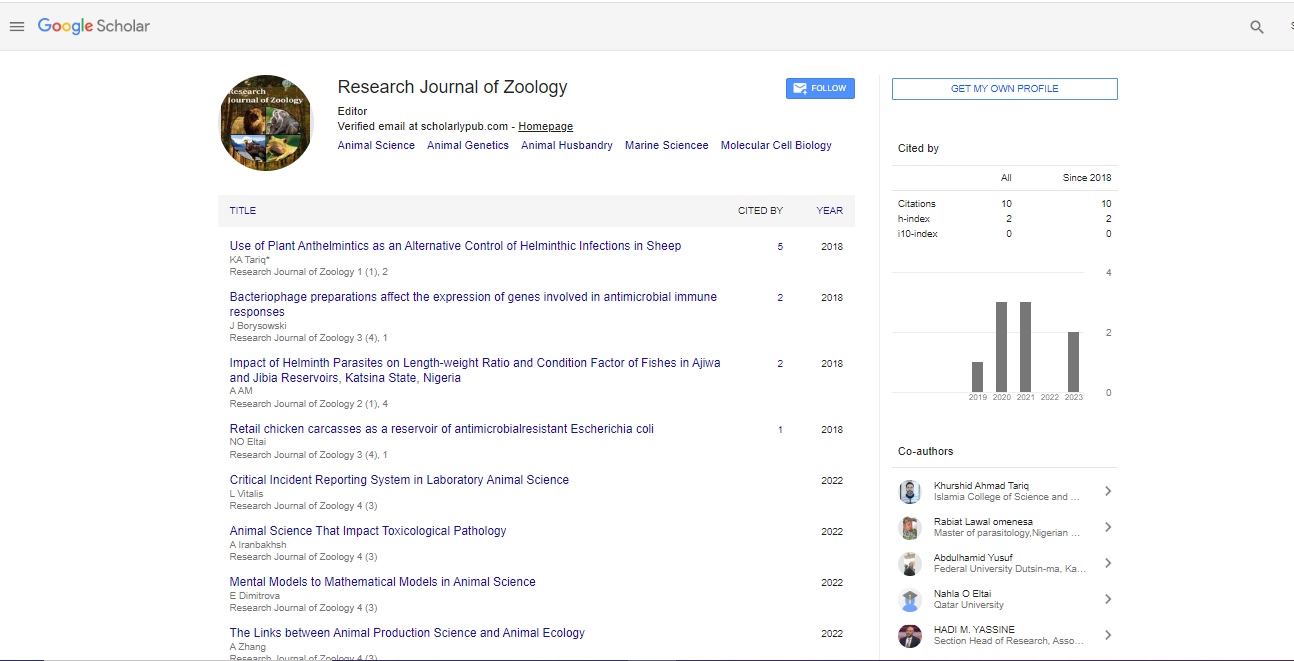Perspective, Res J Zool Vol: 5 Issue: 1
Mechanism of Homeostasis in Human Body
Chanlr Figi*
Department of Medical Laboratory Science and Biotechnology, Asia University, Taichung, Taiwan
*Corresponding Author: Chanlr Figi
Department of Medical Laboratory Science and Biotechnology
Asia University, Taichung, Taiwan
E-mail: chanlr198figi@gmail.com
Received date: 20-Feb-2023, Manuscript No. RJZ-23-95660;
Editor assigned date: 22-Feb-2023, PreQC No. RJZ-23-95660 (PQ);
Reviewed date: 09-Mar-2023, QC No. RJZ-23-95660;
Revised date: 16-Mar-2023, Manuscript No. RJZ-23-95660(R);
Published date: 23-Mar-2023, DOI: 10.4172/Rjz.1000076.
Citation: Figi C (2023) Mechanism of Homeostasis in Human Body. Res J Zool 5:1.
Description
Homeostasis is a fundamental concept in biology that refers to the body's ability to maintain a stable internal environment despite changes in external conditions. It is a dynamic process that involves various physiological mechanisms working together to keep the body in a state of balance. From regulating body temperature to maintaining blood sugar levels, homeostasis plays a crucial role in ensuring the body functions optimally.
Importance of homeostasis
The human body is a complex system that is constantly exposed to internal and external changes. For example, changes in temperature, blood pressure, and glucose levels can have detrimental effects on the body if not regulated properly. Homeostasis serves as a defense mechanism that allows the body to adapt and respond to these changes, maintaining a state of equilibrium. One of the most important aspects of homeostasis is maintaining body temperature. The human body needs to stay within a narrow temperature range of around 98.6°F (37°C) for optimal functioning. When the body gets too hot or too cold, it can disrupt cellular functions and lead to health issues. Homeostatic mechanisms such as sweating or shivering help regulate body temperature by adjusting blood flow, sweat production, and muscle contractions. Another crucial aspect of homeostasis is maintaining blood sugar levels. The body relies on glucose as a primary source of energy. Homeostatic mechanisms such as insulin and glucagon release from the pancreas help regulate blood sugar levels by storing or releasing glucose from storage sites like the liver.
Mechanism of homeostasis
Homeostasis involves intricate physiological mechanisms that work together to maintain stability in the body. These mechanisms can be broadly categorized into three main types-sensor mechanisms, integrator mechanisms and effector mechanisms. Sensor mechanisms are responsible for detecting changes in the internal or external environment of the body. These sensors are specialized cells or organs that are sensitive to specific changes, such as changes in temperature, pressure, or chemical concentrations. For example, the skin contains thermo receptors that detect changes in external temperature, while the pancreas contains chemoreceptors that detect changes in blood sugar levels. Integrator mechanisms process the information received from the sensor mechanisms and determine the appropriate response. The integrator compares the current state of the body with the desired state and sends signals to the effectors to take corrective actions. The brain, particularly the hypothalamus, plays a crucial role in integrating information from various sensors and coordinating appropriate responses. Effector mechanisms are responsible for executing the response determined by the integrator. These mechanisms are typically muscles or glands that carry out the necessary actions to restore balance in the body. For example, if the body temperature is too high, the effector mechanisms may initiate sweating to cool down the body while if the blood sugar levels are too low, the effector mechanisms may stimulate the release of glucagon to increase glucose levels. Homeostasis is evident in various physiological processes in the human body.
Thermoregulation: The body constantly regulates body temperature to maintain stability. When the body gets too hot, the sweat glands release sweat, which evaporates and cools the body down. On the other hand, when the body gets too cold, muscles contract, and shivering generates heat to warm the body up. Blood sugar regulation: The body regulates blood sugar levels to ensure a stable energy supply.
 Spanish
Spanish  Chinese
Chinese  Russian
Russian  German
German  French
French  Japanese
Japanese  Portuguese
Portuguese  Hindi
Hindi 
